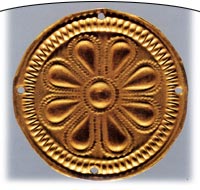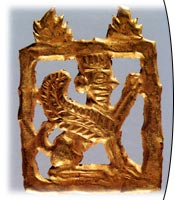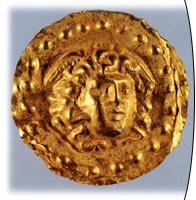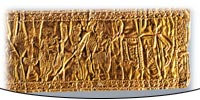Appliques
ANCIENT JEWELLERY EXHIBITED IN ANATOLIAN CIVILIZATIONS MUSEUM
Cloth Jewellery
Appliques
They are ornamental elements attached to any objects or cloths. They are seen in every period and most of the finds are made of gold.
 | Name: | An Applique, a rosette |
| Type: | Gold |
| Location where it came from: | Gordion |
| Way of Coming: | Confiscation |
| Dimensions: | D: 2.5 cm |
| Weight: | 1.38 gr |
| Period | The 7-6th century BC |
It is made of a thin sheet of gold with a repousse technique. It has four string passage holes to be stitched to the cloth. An eight - leaf rosette made with relief points and a frame ornaments around the plate
 | Name: | An Applique, a sphinx |
| Type: | Gold |
| Location where it came from: | Sarayköy |
| Way of Coming: | Confiscation |
| Dimensions:: | H: 3.8cm W:2.9cm |
| Weight: | 3.24 gr |
| Period: | The 6th century BC |
It is cut from a golden sheet and is made with a repousse technique. A sphinx with polos and a beard sits in a rectangular frame. It has risen its left front foot. There are two projections on the frame that can be taken for towers. On the back side of the applique, on the corners and behind the towers, there are attachment rings.
 | Name: | An Applique |
| Type: | Gold |
| Location where it came from: | Kütahya |
| Way of Coming: | Purchase |
| Dimensions: | D:1.9cm |
| Weight: | 0.37gr. |
| Period: | The 2-1st century BC |
In the middle of a disc-shaped, very thin, golden plate, there is a Medusa head and relief points around it made with hammering on male mould technique. The Medusa head is slightly turned to the left. The snakes between her big curled hair that goes down to the neck and on the neck, the heads of two snakes look towards each other. The two wings are seen on her head. This type of Medusa heads dated to the Late Hellenistic Period is frequently seen in the Late Hellenistic and Roman Period Jewellery.
 | Name: | An Applique, a plate |
| Type: | Gold |
| Location where it came from: | Sarayköy |
| Way of Coming: | Confiscation |
| Dimensions:: | L:13.5cm W:3.3cm |
| Weight: | 6.2 gr. |
| Period: | The 1st century AD |
A rectangular golden plate has four string passage holes on two ends. In the frame consisting of a knitting band placed between two rows of point series, four figures, one sitting, the other standing, are represented. In the middle of the triple group on the left, there is a lotus flower on a stepped base, a "flag" beside it and a "legion eagle" on the other side of it is placed. On the other side of the scene (right), there are three shields put aside in vertical position as the correspondence of this triple. The one at the end has an appearance of rather a bow. The two man figures just on the left of the shields, with their heads bare, given in the profile without beards stand face to face. The taller figure on the left holds a legion eagle in his right hand and the other figure holds a staff or a standard in his left hand. They have put these on the floor in vertical position and have pulled the object in other hand towards their laps. Here, both figures are represented in mirror symmetry. In other words, they hold the objects in different hands.
There is a based lotus behind the figure on the left, which is turned right, as in the middle of the triple. The third figure of the scene that comes later is a naked woman figure that has leaned her right arm to a column bending it from the elbow, represented from the back side, turned towards left, and with cloth fallen to the knees. In her right hand leaned against the column, there is a palm branch with a long stem and she holds a Globe in her left hand which is held out forward. There is an object just in front of her feet, which could not be determined (fire altar?). In front of this figure, a part that is equal to approximately 1/5 of the whole scene is almost left empty. Here, there is an abundance horn in front of the woman and two birds flying one after the other at the upper left side are represented.
A figure coming afterwards is the only sitting figure of the scene. He sits on a throne on a low platform on which a flag, a legion eagle and a based lotus are located. At the end of this platform, there is a bird just at the bottom of the feet of the sitting figure. The figure leans its arm against the arm of the throne and holds out a branch forward with his left hand. It is understood that it has a long cloth and a cap like a crown or polos. Its right foot hangs downwards from the side of the platform, or it has placed its foot on an aisle there.
The hair and beardless faces of the figures standing across each other shows that this plate belongs to the 1st century AD. Therefore, it would be appropriate that we assume that the scene on the plate reflects a historical event of that period. The female figure in the middle is not anybody but Venus offering peace to the world with the palm branch in her hand. This peace offered to the world comes as the result of a victory won, as can be understood from the flag. A legion eagle and the shields are depicted on both sides of the scene. Peace is symbolized with the sitting figure, who is a goddess, which Julius - Claudius dynasty was proud of coming from her race. With her long cloth, the cap for which the definite form could not be determined and with the phoenix at the end of her foot representing the east, this is a representative of an eastern country. After commenting on all figures in this way, it will be necessary to find the historical event with which this scene is connected.